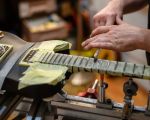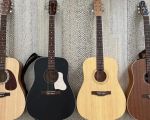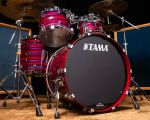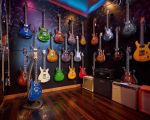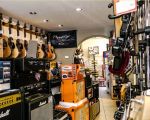Understanding Guitar Effects Pedals: The Basics
When you first start playing the guitar, you may wonder how some musicians seem to have a much richer, more dynamic sound. One of the main tools they use is the guitar effects pedal. These devices allow you to manipulate your sound in various ways, from adding depth and warmth to completely altering the tone. But how do you use guitar effects pedals to enhance your sound? Let’s dive into the basics of effects pedals and how they can transform your playing.
1. What Are Guitar Effects Pedals?
Guitar effects pedals are small, portable devices that process your guitar signal and alter its sound. These pedals sit between your guitar and amplifier, allowing you to control everything from distortion to delay, reverb, modulation, and much more. The primary goal of using these pedals is to shape your sound in a way that enhances your playing and allows you to experiment with a variety of sonic textures. Whether you're looking for a heavy distortion or a subtle reverb, there’s a pedal for every need.
Types of Guitar Effects Pedals
There are many types of guitar effects pedals, each with its unique purpose:
- Distortion/Overdrive: These pedals are known for adding grit and intensity to your tone, making them ideal for rock and metal genres.
- Delay: Delay pedals add an echo effect to your sound, which can make your playing feel bigger and more atmospheric.
- Reverb: Reverb pedals simulate the acoustics of different environments, making your sound feel like it's coming from a large hall or a small room.
- Modulation: These pedals, including chorus, flanger, and phaser, add movement to your sound by modulating the pitch or time of your signal.
- EQ (Equalizer): EQ pedals adjust the frequency response of your signal, allowing you to boost or cut certain frequencies for a more balanced tone.
2. How to Use Guitar Effects Pedals to Enhance Your Sound
Once you have an understanding of the different types of pedals, the next step is figuring out how to incorporate them into your playing. Here's how to use guitar effects pedals to elevate your sound:
Start with a Pedalboard Setup
The first step in enhancing your sound with effects pedals is to create an effective pedalboard setup. Arrange your pedals in a way that allows you to access them easily and maintain an organized signal chain. Typically, distortion pedals should go first, followed by modulation effects (like chorus or phaser), and then delay and reverb at the end. The order can affect the way the pedals interact with each other, so experimentation is key.
Experiment with Different Combinations
One of the most exciting aspects of using guitar effects pedals is the ability to experiment with different combinations. For instance, you can try layering a chorus pedal with a delay for a spacious, dreamy sound, or combine overdrive with a reverb pedal for a thicker tone. Each combination can unlock new sonic possibilities. Don't be afraid to try unconventional setups—some of the best sounds come from unexpected pairings!
3. Tone Shaping with Effects Pedals
One of the most important uses of guitar effects pedals is tone shaping. Your guitar’s natural tone can be enhanced with a variety of effects to create a sound that's uniquely yours. For example, a clean, bright guitar tone can be warmed up with a bit of overdrive, while a muddy sound can be cleared up using an equalizer pedal. Let’s explore how different pedals can shape your sound:
Using Overdrive and Distortion Pedals for Tone Enhancement
Overdrive and distortion pedals are perfect for shaping the harmonic content of your sound. By adjusting the gain and tone controls, you can go from a clean, bluesy sound to a high-gain rock tone. These pedals also work well with other effects such as delay and reverb, making them an essential part of any pedalboard setup.
EQ Pedals for Precise Tone Control
If you're looking for more control over your sound, an EQ pedal can be a game-changer. With an EQ pedal, you can tweak individual frequency bands to cut or boost specific ranges. This can help you clean up a muddy low end, brighten your high end, or bring out the mids for a more punchy sound. EQ pedals are especially useful in live performance settings, where they allow you to adjust your tone on the fly depending on the acoustics of the room.
4. Using Reverb and Delay Pedals for Depth
Reverb and delay pedals are essential for adding depth and dimension to your sound. Whether you're aiming for a lush, ambient tone or an echoing, spacey vibe, these pedals can take your playing to the next level.
Delay Pedals
Delay pedals repeat your signal after a set amount of time, creating an echo effect. Depending on the settings, you can get everything from a subtle slapback echo to long, atmospheric delays that fill up the space. Delay is particularly useful for solos or creating ambient backdrops in your music.
Reverb Pedals
Reverb pedals simulate the natural reflection of sound waves in various environments, such as a small room, a concert hall, or a cavernous space. Reverb adds a sense of space to your playing and is especially useful for ambient music or making solos sound more expansive.
5. Advanced Techniques for Using Guitar Effects Pedals
Once you've mastered the basics of using guitar effects pedals, you can explore more advanced techniques to truly enhance your sound. For example, using a looper pedal allows you to record your playing and layer multiple effects on top, creating complex textures. Other advanced techniques include using expression pedals for real-time control over effects and incorporating MIDI controllers for seamless integration of multiple effects during a performance.
6. Popular Pedal Combinations and Settings
When setting up your pedalboard, certain combinations of pedals work well together to create specific sounds. For example, combining a distortion pedal with a delay can give you a classic rock tone with a bit of space. If you're after a more modern, ambient sound, you might combine a reverb pedal with a chorus. Popular pedal combinations include:
- Overdrive + Delay
- Chorus + Reverb
- Distortion + EQ
- Phaser + Delay
These combinations can add layers to your sound and help you craft the perfect tone for your music.
Conclusion: Finding Your Unique Sound with Guitar Effects Pedals
Using guitar effects pedals to enhance your sound is all about experimenting and finding the right combination that works for you. Whether you're shaping your tone with overdrive, adding depth with delay, or experimenting with EQ, there are endless possibilities to explore. The key is to experiment, trust your ears, and most importantly, have fun with it. So, if you're ready to take your guitar playing to the next level, start exploring the world of effects pedals and discover the unique sound that best represents your musical style.

